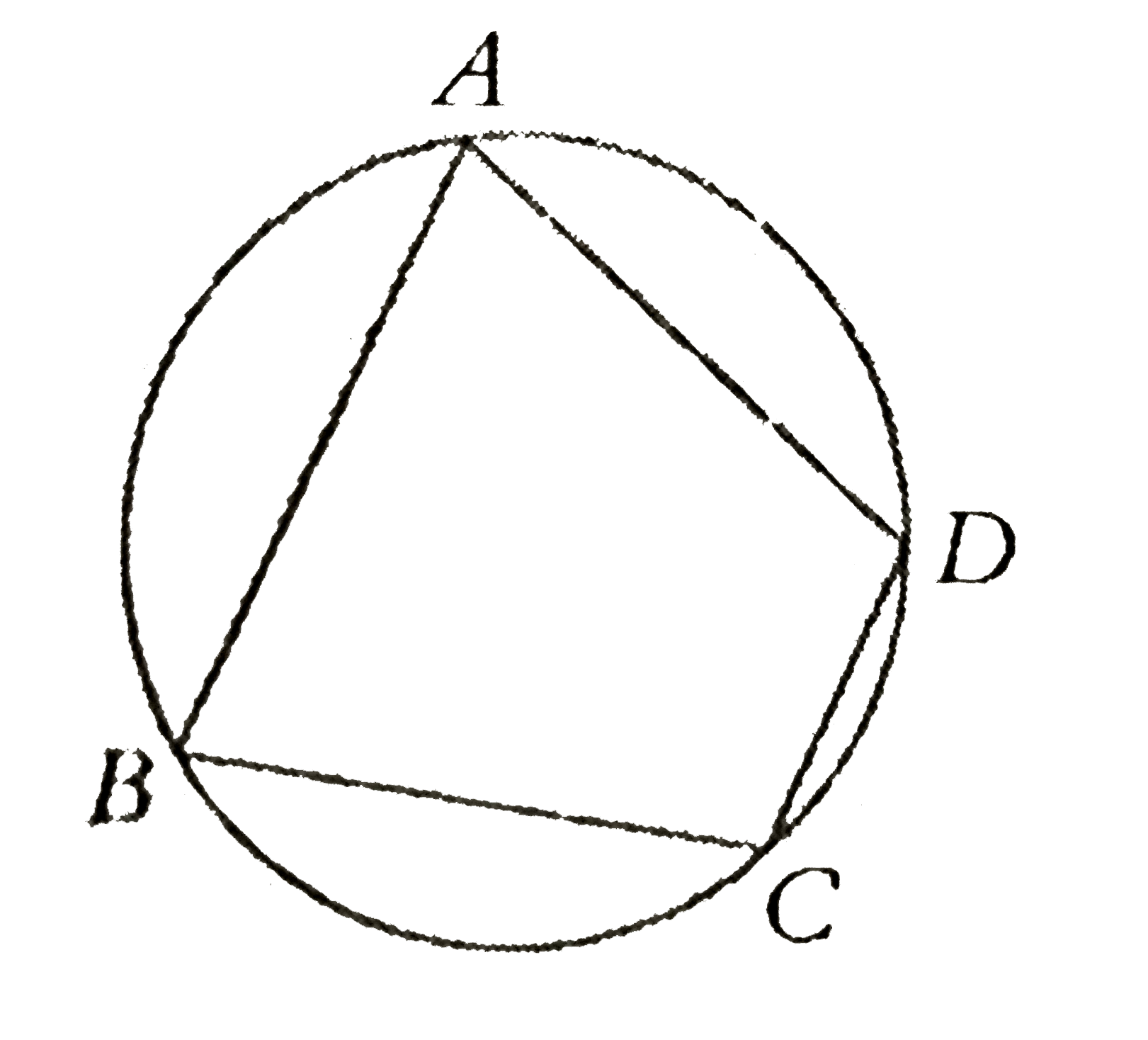ABCD is a cyclic quadrilateral. If AD∣∣BCand∠B=70∘, find the other angles of ABCD.
The correct Answer is:∠A=110∘,anglaC=70∘,∠D=110∘
To solve the problem, we need to find the angles of the cyclic quadrilateral ABCD given that AD is parallel to BC and angle B is 70 degrees.
1. Identify the Given Information:
- We know that ABCD is a cyclic quadrilateral.
- AD is parallel to BC.
- Angle B = 70 degrees.
2. Use the Property of Cyclic Quadrilaterals:
- In a cyclic quadrilateral, the sum of opposite angles is equal to 180 degrees.
- Therefore, we can write the equation for angles B and D:
Angle B+Angle D=180∘
- Substituting the value of angle B:
70∘+Angle D=180∘
3. Calculate Angle D:
- Rearranging the equation gives us:
Angle D=180∘−70∘=110∘
4. Use the Parallel Lines Property:
- Since AD is parallel to BC, we can use the property of alternate interior angles.
- Therefore, we have:
Angle D=Angle A+Angle B
- This means:
110∘=Angle A+70∘
5. Calculate Angle A:
- Rearranging gives us:
Angle A=110∘−70∘=40∘
6. Find Angle C Using Opposite Angles Property:
- Again, using the property of cyclic quadrilaterals:
Angle A+Angle C=180∘
- Substituting the value of angle A:
40∘+Angle C=180∘
7. Calculate Angle C:
- Rearranging gives us:
Angle C=180∘−40∘=140∘
Summary of Angles:
- Angle A = 110 degrees
- Angle B = 70 degrees
- Angle C = 140 degrees
- Angle D = 110 degrees
Final Answer:
- Angle A = 110°
- Angle B = 70°
- Angle C = 140°
- Angle D = 110°
- We know that ABCD is a cyclic quadrilateral.
- AD is parallel to BC.
- Angle B = 70 degrees.
- In a cyclic quadrilateral, the sum of opposite angles is equal to 180 degrees.
- Therefore, we can write the equation for angles B and D:
Angle B+Angle D=180∘
- Substituting the value of angle B:
70∘+Angle D=180∘
- Rearranging the equation gives us:
Angle D=180∘−70∘=110∘
- Since AD is parallel to BC, we can use the property of alternate interior angles.
- Therefore, we have:
Angle D=Angle A+Angle B
- This means:
110∘=Angle A+70∘
- Rearranging gives us:
Angle A=110∘−70∘=40∘
- Again, using the property of cyclic quadrilaterals:
Angle A+Angle C=180∘
- Substituting the value of angle A:
40∘+Angle C=180∘
- Rearranging gives us:
Angle C=180∘−40∘=140∘
- Angle A = 110 degrees
- Angle B = 70 degrees
- Angle C = 140 degrees
- Angle D = 110 degrees
- Angle A = 110°
- Angle B = 70°
- Angle C = 140°
- Angle D = 110°
Topper's Solved these Questions
- CIRCLES BOOK - NAVNEET PUBLICATION - MAHARASHTRA BOARDCHAPTER - CIRCLES EXERCISE - MULTIPLE CHOICE QUESTIONS (MCQ.s)
14 Videos
- CIRCLES BOOK - NAVNEET PUBLICATION - MAHARASHTRA BOARDCHAPTER - CIRCLES EXERCISE - SUM TO ENRICH REMAMBER
6 Videos
- CIRCLES BOOK - NAVNEET PUBLICATION - MAHARASHTRA BOARDCHAPTER - CIRCLES EXERCISE - EXERCISE 10.6
10 Videos
- INTRODUCTION TO EUCLID.S GEOMETRYBOOK - NAVNEET PUBLICATION - MAHARASHTRA BOARDCHAPTER - INTRODUCTION TO EUCLID.S GEOMETRYEXERCISE - MULTIPLE CHOICE QUESTIONS
3 Videos
Similar Questions
Knowledge Check
ABCD is a cyclic trapezium such that AD || BC. If ∠ABC=70∘, then the value of ∠BCD is :
A60∘B70∘C40∘D80∘If ABCD is a cyclic quadrilateral with ∠A=50∘,∠B=80∘ , then ∠C and ∠D are
A130∘,100∘B115∘,115∘C110∘,120∘D130∘,100∘
In the above figure, ABCD is a cyclic quadrilateral and ∠BCD=2∠BAD. Find the angle made by the diagonal BD at the centre of the circle.A60∘B80∘C100∘D120∘
In the figure, □ABCD is a cyclic quadrilateral. seg AB is a diameter. If ∠ADC=120∘, find the measure of ∠BAC.

View SolutionABCD is a cyclic trapezium in which, AD| |BC and ∠B=70∘. Find its remaining angles,
View SolutionIn Figure, ABCD is a cyclic quadrilateral. Find the value of x
View SolutionABCD is a cyclic trapezium , in which AB||DC. If ∠B=75∘ , then find other angles.
View SolutionIn Figure ABCD is a cyclic quadrilateral. If ∠BCD=1000and ∠ABD=700, find ∠ADB
View Solution


